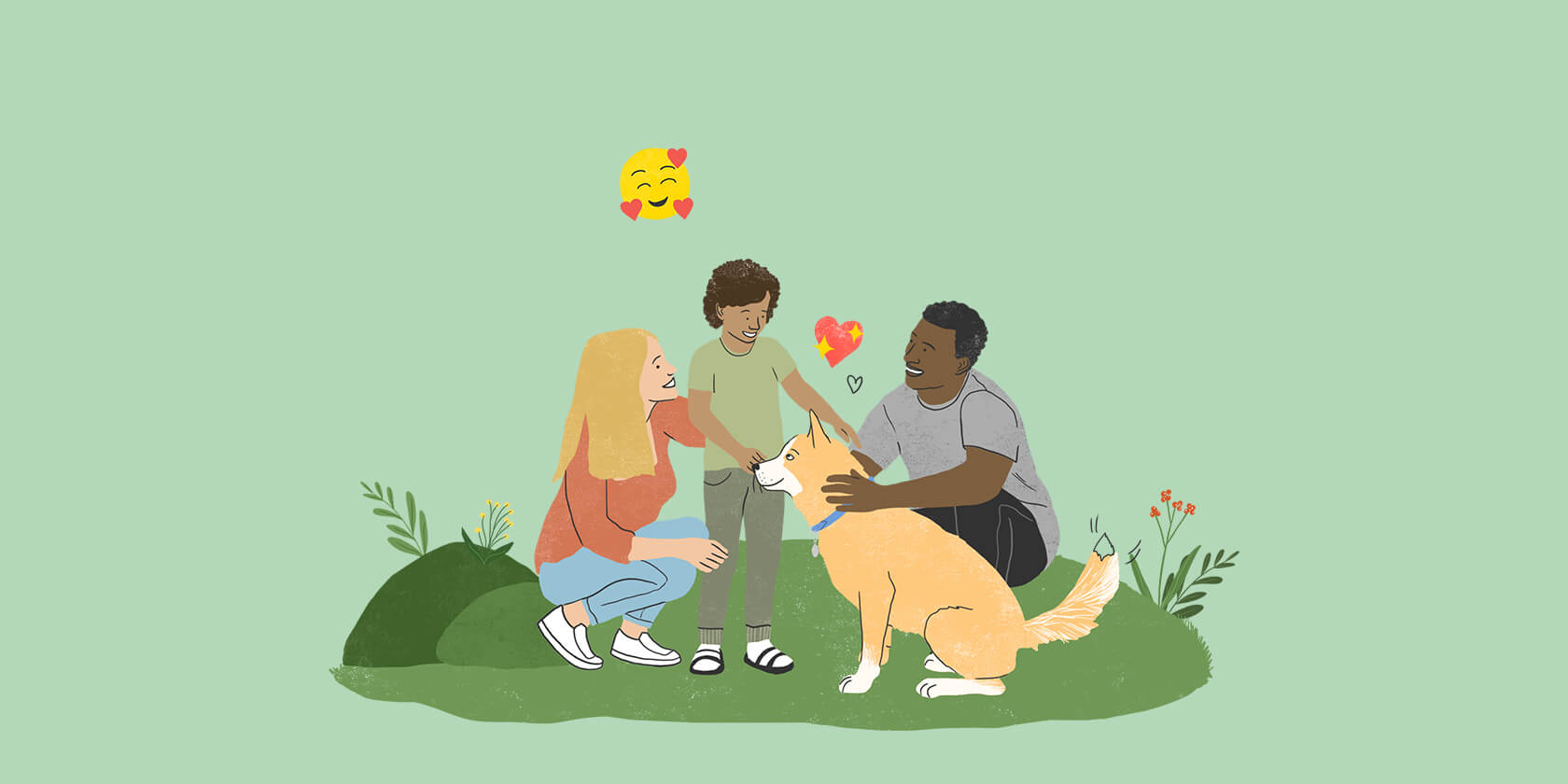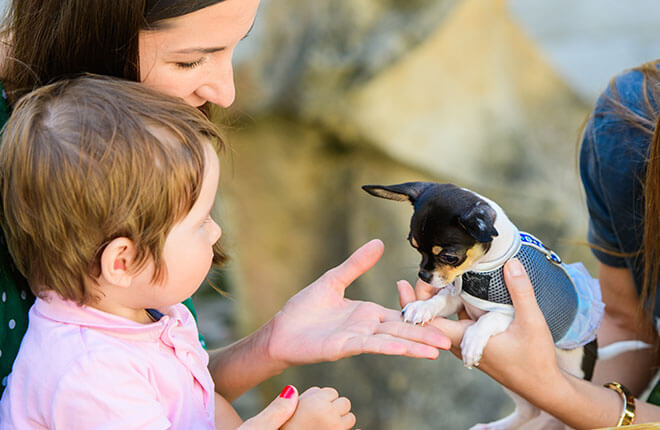Adding a new dog or cat to your family is an exciting time! Children and their pets can share a special bond, and how you introduce them can go a long way in making sure both feel comfortable and safe. By carefully managing your new pet's first introduction and ongoing interactions with your children, you'll be starting their relationship off on the right paw.

Have a Plan
Whether the first meeting is in a shelter, someone else's home, or your home, the goal is to make the experience as calm as possible while creating positive associations for your new pet and your children. It can sometimes be intimidating — or even scary — for a child to meet a new animal for the first time. And it can also be scary for a new pet if a child rushes up to them, pets or touches them enthusiastically, or makes a lot of noise. Make sure you have a plan and that the kids know what to expect, how to act appropriately, and how to calmly greet their new family member. You can even practice as a family to speak quietly and move more slowly before meeting the pet.
Establish Safe Spaces
Create safe spaces for your pet and teach your children that these spaces are off-limits to them. When your dog or cat heads to their safe place, they should be given some alone time and should not be bothered. Your safe space setup will be somewhat different depending on your home’s layout and whether you have a cat or a dog.
- Cats. They love just about any small, enclosed place they can snuggle up and feel secure. You can buy covered cat beds or caves, but sometimes a cozy blanket on top of (or under) the bed or tucked away in a corner behind the couch is just as good. Some cats prefer raised spots like a cat tree or a cat bed on top of a dresser.
- Dogs. Your new dog should always have a crate (or secure playpen for puppies). Make the crate a safe, comfortable space and a positive environment by providing crate time — keeping the door open — with treats, toys, and even your dog’s meals. In addition to a crate, consider setting up a dog bed in a quiet part of your home.
Keep Introductions Calm and Positive
Try these tips for relaxed engagement:
- Don't force interaction. If your new dog or cat is unsure or shy, allow them to approach on their own time. There's no need to offer an outstretched hand for the animal to sniff — they can smell you just fine from further away, and often an outstretched hand over their head is scary. Your children can toss treats on the ground, which protects their hands from being accidentally nipped or scratched in the excitement of eating a treat and creates a positive association for the pet around your child. For cats, it may take several days for them to get comfortable in their new environment; allow them time to hide and explore without trying to pet or pick them up.
- The "petting consent" test. A great way to evaluate how a pet feels about being pet or touched by a child is to practice the consent test. If the pet approaches for contact, have your child pet them for two to three seconds and then stop. If the pet moves closer or indicates they would like more petting, your child can start petting again. If they move away or seem unsure, simply toss a treat on the floor away from you and give them a break. Practicing this consent test regularly during child-pet interaction ensures that your new pet enjoys the attention and touch and reassures them that they can move away when needed instead of escalating defensive behavior if they feel threatened.
- Fun games. If you have a new dog who's bursting with excitement, channel that energy into entertaining training games that encourage calm behavior and prevent jumping or mouthing during introductions. Fetch is a great training game, providing physical activity without much close physical contact. For cats, try using toys that allow your children to play and interact from a distance, like wand toys. It may be best to hold off on play until your cat seems comfortable in their new surroundings. Like dogs, they can become overwhelmed while they're getting their bearings in a new environment. Always provide positive reinforcement with verbal praise (a calm but cheerful tone works best) and treats to maintain a good experience for all involved.
Learn Your New Pet's Language
Animals are always communicating with their body language. Children must be taught which signals might mean their new family pet is feeling uncomfortable or needs space.
Here are a few early warning signs that a dog is feeling overwhelmed:
- Yawning
- Lip licking
- "Whale eye" (when you can see the whites of the dog's eyes)
- Head lowered and neck extended
- Ears pinned backward against their head
- Suddenly closing their mouth
- Tail tucked
- Front paw raised
If you're adding a new cat to the family, watch for these early warning signs of stress:
- Wide eyes or darting glances around the room
- Crouching low to the ground, as if they're ready to dart
- Arched back
- Puffed up tail
- Growling and/or hissing
- Ears pointed sideways ("airplane ears")
- Ears pinned backward against their head
If these more subtle signals are ignored, a dog or cat will often feel the need to escalate their defensive warnings to a growl, air snap, scratch, or even bite. Talk with your children about the importance of watching for these behavioral cues and removing themselves from the situation before your new pet acts out in fear.
Introducing a New Pet to Your Baby or Toddler
Introducing a new pet to an infant or toddler requires close supervision and environmental management to ensure safety. It's best to always have some form of protected contact in these situations. Beyond creating a safe space for your baby and your pet, as discussed above, here are a few more tips for creating a safe introduction:
- Always keep an adult between your new pet and your baby. Hold your baby on the opposite side of your body from where your dog or cat is. This gives you more space to work with, and you can reward your pet with treats and praise for staying calm and to create a positive association with the baby's presence.
- Allow your new pet to sniff items with your baby's scent on them. Try a blanket sniff before having them in closer proximity to each other. Dogs and cats are naturally curious, and scent tells them so much about a new person. When your child’s scent becomes more familiar — and it helps when there are treats or other rewards close by that scent — your pet will develop a positive association.
- Use baby gates to separate space. Baby gates work very well to manage dog interactions. Give your new dog something positive and engaging to do in a separate and secure area, such as a stuffed interactive food toy or puzzle behind a baby gate or in their crate or pen. For cats, try a large, fully enclosed exercise pen or crate. You can also use baby gates. But be mindful of your cat’s jumping abilities and consider stacking a couple of gates on top of each other.
- Be aware of your child’s mobility. As young children grow up, they seem to always be on the move. While your toddler figures out their balance and speed moving around the house, make sure you take this into account when they are close to your new pet. Quick movements can result in a quick reaction from both species, so gentle restraint of your toddler can help you maintain space and safety for your new pet when they are nearby.
For a child, there is nothing quite like growing up with a pet. That first meeting and those first few days together are important to set the stage for their relationship moving forward. That might seem like a lot of pressure as a parent, but don't worry. Following these simple guidelines will get things going smoothly and help you enjoy every minute watching your new dog or cat bond with your child.
ZPC-01086R1



